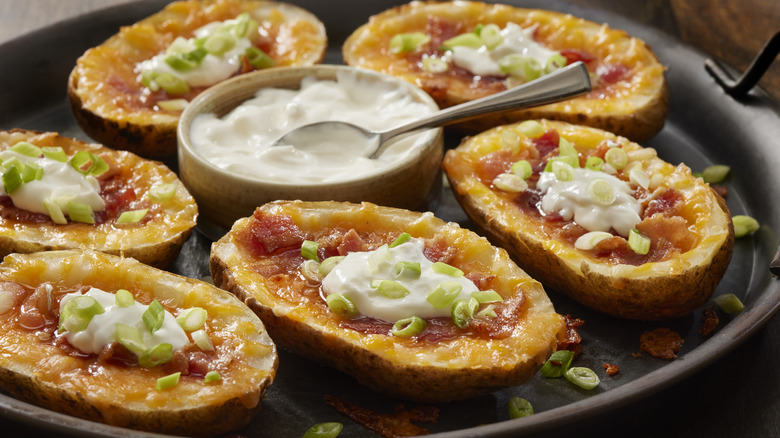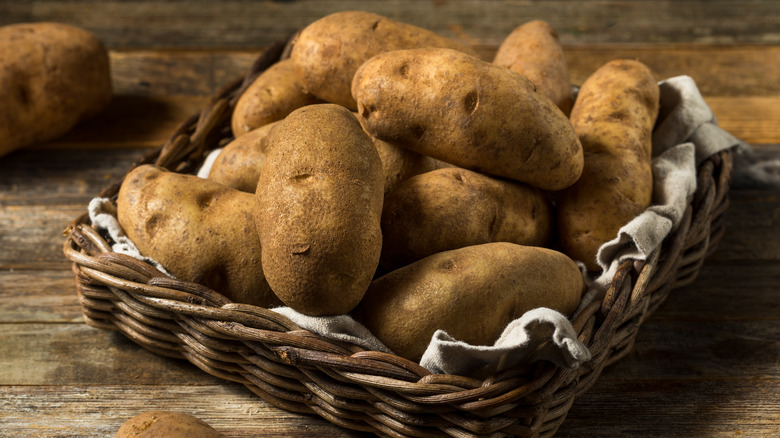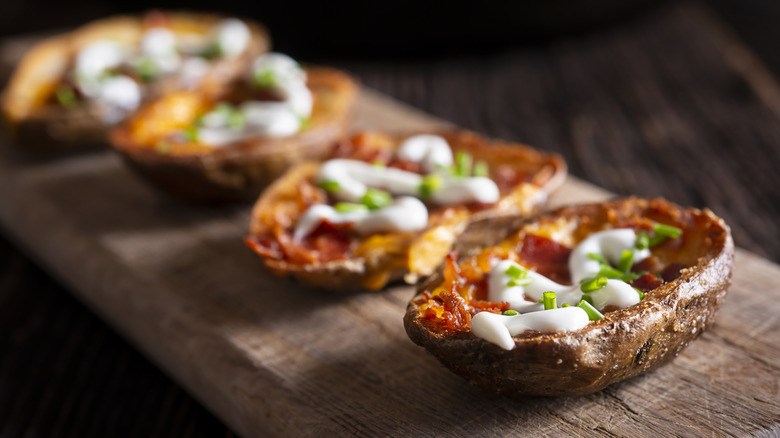What Are The Best Type Of Potatoes For Making Potato Skins?
Potatoes can cover so many bases. Whether fried up into french fries, shredded into potato pancakes, or baked into au gratin, the humble spud can seemingly do no wrong in the kitchen. They're also all-stars when it comes to food waste because potato skins are perfectly edible. Yes, you can leave the skins on when boiling potatoes for mashing or salads, but when it comes to eating the entire spud, baked potato skins are the real deal. The scooped-out husks of baked potatoes are the perfect vehicle for shredded cheddar cheese, sour cream, and bacon, and few can resist a skin or two at a party or potluck.
If you're shopping for snacks for Sunday's game, don't overthink it on the potato skins. For the best skins in the game, go with russet potatoes. There are a lot of choices in potatoes at the grocery store these days, but russets are the go-to for classic potato skins because they have the heft to stand up to scooping, stuffing, and a second baking. Plus, russets are easy to scrape out without too much fuss, and they hold their shape after they're baked.
Another plus: Russets are super common and inexpensive, and even if you don't have a lot of cooking skills you can make them into amazing potato skins.
It's all about the fiber
Potato skins as we know them — served up with cheese and toppings — have been around since the 1970s, and were probably invented to (wisely) make use of potato peels that would normally be discarded. While TGI Friday's may or may not have invented the appetizer, it's become an American classic in the decades since the chain added them to the menu in 1974, according to Eater.
The basic steps for making skins require baking the potato and then scooping out the flesh with a spoon, leaving behind a thin layer of potato. Then the skin is either baked again with a little butter and salt, or deep fried. Finally, it's topped with fixings and served — or sometimes baked a third time, if there's melted cheese involved. To get through all those steps, the potato needs to have a firm skin that won't rip or tear while you're scooping away the insides. Russet potatoes are ideal because their skin is chewy and fibrous, which makes them stronger than the skins on other types of potatoes.
It's easy to make baked potato skins at home with almost any kind of potato, but when compared to Yukon Gold or regular white potatoes, there's no competition. Russets have the thickest skins, which some people discard because they're almost too chewy. As a bonus, they get super crispy when you bake them, and you'll get a satisfying crunch without losing any toppings to sogginess.
Russets are extremely common
Another reason why russets are perfect for making potato skins is that they're typically about the size of the palm of a hand, which makes it easy to hold them and get a spoon inside for scooping. Smaller potatoes like Yukon Golds can make tasty, crispy potato skins, but it can be a pain trying to get the baked potato flesh out and it's really easy to rip the skin in the process. Not so with russets; with the right spoon, you can hold the potato in one hand and use the other to clean out the fluffy potato bits with just one or two passes.
The ubiquitous russet potato is easy to find all around the U.S. They're grown in several states, and because they're so common, they are also usually inexpensive. Just be sure to give your potatoes an extra good scrubbing before you bake them so that you get any grit off the skin — russets and other types of potatoes aren't typically washed before they're packaged, in order to prevent mold, according to the Idaho Potato Commission, and nobody wants dirt in their halftime snacks.


